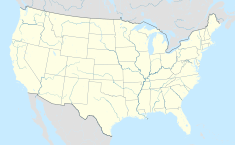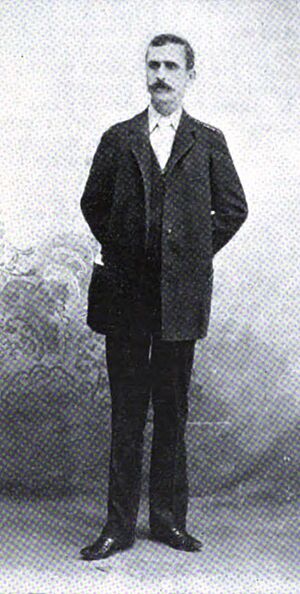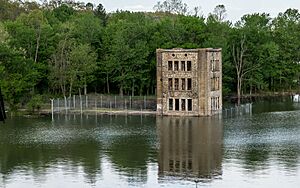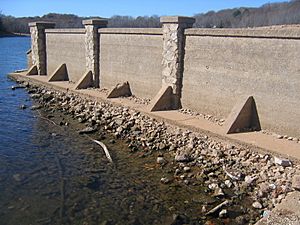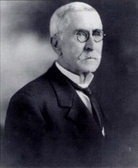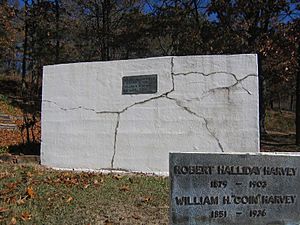Monte Ne facts for kids
Quick facts for kids |
|
|
Monte Ne
|
|
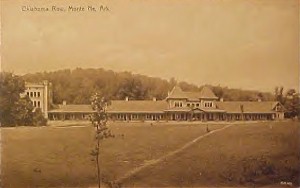
"Oklahoma Row" Hotel in 1910
|
|
| Location | Benton County, Arkansas, United States |
|---|---|
| Nearest city | Rogers |
| Area | 0.1 acres (0.040 ha) |
| Built | 1900–1930 |
| Built by | W. H. "Coin" Harvey |
| Architect | A. O. Clarke |
| NRHP reference No. | 78000575 |
| Added to NRHP | February 2, 1978 |
Monte Ne was a special health resort and planned community. It was created by a man named William Hope Harvey and operated from 1901 into the 1920s. Monte Ne was located in a valley near Rogers, Arkansas. Today, most of it is hidden under the waters of Beaver Lake.
The resort had several hotels, a lake, and even an indoor swimming pool. There was also a golf course, tennis courts, and bowling alleys. Monte Ne even had its own post office and bank! A special train line brought guests right to the resort. There was even an Italian gondola to take visitors around. In 1931, Monte Ne hosted the only presidential convention ever held in Arkansas.
Even with all of Harvey's efforts, Monte Ne didn't make much money. By 1920, the train line was sold, and the Monte Ne Bank closed. Harvey believed that civilization was in trouble. So, he started building "The Pyramid." This was meant to be a huge monument, 130 feet tall. It would hold books and objects from the 20th century. This way, future generations could discover them.
Harvey spent all his money building a large amphitheater as the pyramid's base. The stock market crash of 1929 stopped all plans for the pyramid. When Harvey died in 1936, most of the resort was sold. Some buildings were used until the 1960s. That's when the United States Army Corps of Engineers built a dam on the White River. This created Beaver Lake. The lake flooded almost all of Monte Ne. Only parts of one hotel tower and some foundations were still visible. This tower was taken down in 2023. But when Beaver Lake's water level drops, parts of the mysterious amphitheater can still be seen.
Contents
Meet William Hope 'Coin' Harvey
William Hope "Coin" Harvey was a famous lawyer and businessman in the 1890s. He was also a politician, author, and speaker. His 1894 booklet, "Coin's Financial School", sold over a million copies. This earned him the nickname 'Coin'. Harvey believed in an economic idea called "Free Silver". This idea greatly influenced William Jennings Bryan, who ran for president in 1896. Harvey helped Bryan's campaign.
His campaigning brought him to northwest Arkansas. In 1900, he bought land near a small village called Silver Springs. He renamed the area "Monte Ne." He said these were Spanish and Native American words for "mountain" and "water." Harvey once wrote, "The people of Arkansas are lucky to have no big cities and no super-rich people. That's why I came here to live."
Harvey and his family moved into a house at Monte Ne. In December 1901, the house burned down. Much of their belongings were lost. Harvey's wife, Anna, moved to Chicago. She only returned once, for their son Hal's funeral in 1903.
Building the First Resort Features
In December 1900, Harvey started the Monte Ne Investment Company. He used $52,000 from investors and $48,000 of his own money. The company owned all the land. Early projects included digging a canal and building a lagoon. They also built bridges and walkways for guests.
In 1900, construction began on the first hotel. The Hotel Monte Ne was finished in April 1901. It was three stories tall with two wings, each 300 feet long. The resort's grand opening was on May 4, 1901. A newspaper called it "the most brilliant social event" in that area. It marked "a new era" for Northwest Arkansas.
In July of that year, Harvey brought a 50-foot gondola from Italy. He started offering rides on the lagoon. In August, Harvey's son and brother-in-law opened a bathhouse. It had a 25 by 50-foot indoor pool. This pool had slides, springboards, and heated water. It was the first indoor heated pool in Arkansas! A two-lane bowling alley was also added.
The Monte Ne Railroad
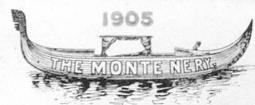 |
|
| Overview | |
|---|---|
| Headquarters | Monte Ne, Arkansas |
| Locale | Arkansas, Monte Ne and Lowell |
| Dates of operation | 1902–1908 |
| Successor | Arkansas, Oklahoma & Western Railroad |
| Technical | |
| Track gauge | 4 ft 8 1⁄2 in (1,435 mm) standard gauge |
Harvey needed a way for people to reach Monte Ne. In 1900, there were not many good roads. Cars were also not very common yet. So, Harvey decided to build a five-mile railroad line. It would connect Monte Ne to the St. Louis and San Francisco Railroad in Lowell, Arkansas.
The Arkansas Railroad Commission approved the plan on April 26, 1902. The Monte Ne Railway Company was started the next month. Harvey bought a train engine, a tender, and a passenger car. He built a large log depot by the lake at Monte Ne. He used his Italian gondola to take guests from the train depot to the hotels. Harvey often said Monte Ne was "the only place in America where the gondola meets the train." The train line opened on June 19, 1902. William Jennings Bryan, a former presidential candidate and friend, spoke at the opening.
Sadly, the railroad was not a big success. Its service was not always on time. Many guests came on special Frisco excursion trains instead. In 1908, the Monte Ne rail line was sold. It was sold again in 1910. Passenger service continued until 1914. The line then carried lumber and other goods for a few more years.
More Hotels for Monte Ne
Harvey wanted to add more hotels to Monte Ne. He hired A. O. Clarke, a successful architect from St. Louis. In April 1904, a new company was formed to build more hotels. Clarke was the main architect. Five hotels were planned. There would be a main building called the Club House Hotel. There would also be four "cottage rows." Each would be named after a state next to Arkansas.
The first two hotels planned were the Missouri Row and the Club House Hotel. Missouri Row was designed to be 46 feet wide and 305 feet long. It was to be built with 8,000 logs and lots of concrete. Red roof tiles were shipped from Chicago. The Club House Hotel was designed with stone and concrete. It was meant to look like a grand Roman villa. It even had an 18-foot-high waterfall in the lobby!
In May 1905, workers were asked to work longer hours without more pay. The workers went on strike, and Harvey fired them. Harvey also had a fight with one worker. The worker was upset about something written about him in the Monte Ne newspaper. The worker said Harvey pulled a gun. Harvey said it was self-defense. The gun was knocked down, and a struggle happened. Harvey needed several days of bed rest after the fight.
The strike was soon over. But work on the Club House Hotel stopped. Even though the first floor was built, it was never finished. All workers focused on finishing the Missouri Row. It opened in September 1905. Rooms cost $1 a day or $6 a week.
With money from almost 300 new investors, building began on the Oklahoma Row in 1907. A.O. Clarke also designed this one. It was another log and tile building. It had a three-story concrete tower on the south end. During this time, Harvey worried a lot about money. He wrote to his wife, "I am trying to save the ship from sinking."
Oklahoma Row opened in 1909. All 40 rooms had electric lights, indoor plumbing, and running spring water. A 1963 newspaper article said it was the largest log hotel in the world. Because of money problems, there was no big party when Oklahoma Row opened.
Monte Ne's Theme Song
In 1901, Harvey asked for a theme song for Monte Ne. "Beautiful Monte Ne" was written by Edward Wolfe, a local from Rogers. Harvey copyrighted it in 1906.
Beautiful Monte Ne, God's gift to man they say
Health resort of all the world is beautiful Monte Ne
Rosy cheeks and purer blood they gain there day by day
in mountain air water rare at beautiful Monte Ne
Businesses and Resort Life
Harvey tried to get businesses to move to Monte Ne. But not many did. Monte Ne's small downtown area once had a general store, a livery stable, a gristmill, and a post office. Harvey even made his own money, called scrip. This scrip was used like cash in Monte Ne. It helped Harvey pay for things without needing a lot of real money upfront.
In 1905, Harvey started the Bank of Monte Ne. He again hired architect A.O. Clarke. Clarke designed a two-story building for the bank and a store. It also had offices upstairs. The bank worked until 1914. Then, all funds were moved to a bank in Rogers.
To attract tourists, Harvey often brought in musicians. He hosted dances and other events to keep Monte Ne lively. His son Tom ran the Monte Ne Herald newspaper to promote these events. The newspaper only lasted until 1905. This was likely due to money problems and Harvey's personal attacks in the paper. Monte Ne also had sports events like tennis, croquet, and fox hunting. A golf course was built before 1909.
Harvey was often hard to please. This sometimes made people leave. He had a rule that all lights had to be out by 10 p.m. At least once, he cut the town's electricity to enforce this rule. Unhappy guests often left the next day. He was also criticized for holding events on Sundays. He also banned children and sick people from the resort.
Roads to Monte Ne
By 1913, the Monte Ne railroad was not doing well. Harvey realized that cars were becoming popular for travelers. In 1913, Harvey helped start The Ozark Trails Association (OTA). This group promoted marking and building good roads. Harvey's main goal was to bring people to Monte Ne. He said, "My personal interest in the Ozark Trails is that they all lead to Monte Ne."
The OTA was probably William Harvey's most successful project. The first meeting was in Monte Ne in 1913. By 1916, their annual meeting in Oklahoma City had 7,000 people! The group built large stone monuments along the roads they supported. These monuments listed the names of people who helped with money.
Interest in the group began to fade. Harvey stepped down as president in 1920. Only 200 people attended that meeting. By the mid-1920s, roads were funded by the government. There was no longer a need for local groups to sponsor them. The OTA's naming system, using many different names, became confusing. So, the U.S. Bureau of Public Roads changed all road names to numbers. The OTA protested, but the group broke up in 1924. However, many of the roads they helped build became part of the famous U.S. Route 66.
The Pyramid Project
By 1920, Harvey had faced many problems. His son Hal died in a train accident in 1903. His other son Tom left in 1908 and never came back. His wife and two daughters moved to Chicago in 1902. His marriage was not doing well. Harvey also lost a political election in 1913. His Monte Ne resort was failing. The railroad was sold, and the bank closed. Few permanent homes or businesses were built. Cars changed how people vacationed. Instead of staying at one resort for weeks, people could now tour the country by car. World War I also affected the world's economy.
Because of these problems, Harvey started to believe that civilization was ending. In February 1920, he wrote a book called Common Sense. In it, Harvey announced his plan to leave a message for the future. This message would be in the form of a pyramid.
Harvey studied the history of the Ozark Mountains. He said they were some of the oldest mountains in the world. He believed they had not been touched by volcanoes or earthquakes. He thought the mountains around Monte Ne would eventually crumble. They would fill the valley with dirt and mud.
Harvey planned to build a huge concrete monument. It would be 130 feet tall. Its top would stay above the debris. Future archaeologists could dig down and find it. He called it "The Pyramid." He spent the rest of his life trying to build it.
The pyramid would hold Harvey's books, explaining 20th-century life. It would also have a world globe, a bible, encyclopedias, and newspapers. Harvey also wanted to put "numerous small items" inside. These included things like needles, safety pins, and even a Victrola (an old record player).
It was estimated that the pyramid would use 16,000 bags of cement. It would also need lots of sand, gravel, and steel. The Portland Cement Association sent an expert. He said the Pyramid would last for over a million years. To protect the foundation from water, Harvey built a 165-foot-long retaining wall of stone and concrete.
He also built a large, curved amphitheater at the pyramid's base. He called it the "foyer." Digging for the amphitheater began in late 1923. Construction continued for five years whenever money, materials, and workers were available. Unlike other Monte Ne buildings, this amphitheater had no clear design. Workers said Harvey seemed to "work it out in his mind from day to day." The result was a unique structure. It could seat 500 to 1,000 people. In the middle was a small island with two concrete chairs and a concrete couch. This was for an orchestra or a speaker. Harvey opened the amphitheater in 1928 to 500 people.
After King Tut's tomb was found in 1922, there was a lot of interest in ancient Egypt. Harvey's Pyramid project also became very popular. Tens of thousands of people visited Monte Ne in the 1920s to see its progress. In just four months in 1928, 20,000 visitors came.
Harvey moved his office next to the amphitheater as work continued. In January 1929, Harvey created The Pyramid Association. This group was meant to finish his pyramid plans if he died. The pyramid itself was estimated to cost $75,000. But Harvey spent all his money building the amphitheater. The stock market crash of 1929 stopped all construction.
In a last effort, Harvey wrote to rich men asking for money. He explained that civilization was dying. He said only wealthy people could save it by sending money for his pyramid. Harvey called his letters "the most important letter ever written." But he received no replies. The pyramid was never built. All that remains is the retaining wall and the amphitheater. They are usually under the waters of Beaver Lake.
A Presidential Convention
As Harvey focused on the Pyramid, Monte Ne's resort days ended. The number of visitors slowly dropped. Harvey sold the Hotel Monte Ne around 1912. In 1927, both the Missouri and Oklahoma Row hotels were sold.
Harvey returned to politics after the 1929 stock market crash and the start of the Great Depression. He decided to run for president. He formed the Liberty Party. They held their national convention at Monte Ne. It was the only presidential convention ever held in Arkansas.
Harvey prepared for 10,000 delegates. He arranged special train rates, media facilities, better roads, and food stands. He put a tent over the amphitheater. He set up seating and a sound system. Delegates could only attend if they had read and agreed with his new book, The Book. This book was about the harmful effects of government usury (lending money at high interest). In the end, only 786 delegates came. Harvey was the only candidate they agreed on. Franklin Delano Roosevelt won the 1932 presidential election. Harvey only received 53,000 votes nationwide. He got only two votes in his home county.
Harvey died on February 11, 1936, at Monte Ne. He died from an infection after getting the intestinal influenza. The tomb built for his son in 1903 was opened. Harvey's pine coffin and his son's were placed in a glass casket. This casket was filled with copies of Harvey's books and papers. The tomb was then sealed again. A small funeral was held on February 14. A small plaque with their names and dates was placed there.
Harvey died with $138 and $3,000 in debt. He had no will. The courts decided that the property still owned by the Pyramid foundation belonged to his widow, May. She sold it before moving to Springfield, Missouri. She never returned and died in 1948.
What Happened After Harvey?
The hotels and buildings at Monte Ne had many different futures after Harvey's death. The Monte Ne Inn, which Harvey sold in 1912, kept operating under different names. These included the White Hotel, Randola Inn, Hotel Frances, and the Sleepy Valley Hotel.
From 1927 to 1932, the Missouri and Oklahoma Row hotels were used as the Ozark Industrial College and School of Theology. In 1944, they were sold to local businessmen. The Missouri Row was torn down and sold in pieces. By 1956, it was reported that Missouri Row had fallen into rubble.
In 1923, Iris Armstrong leased land near Monte Ne. She started Camp Joyzelle, a summer camp for girls aged 8 to 17. It focused on drama and arts. The camp used the old Monte Ne train depot as its main office. They also used the amphitheater for their plays. William Harvey, who usually didn't like children, often watched these performances. The camp continued until the early 1960s, when Beaver Lake flooded the area.
The Bank Block, where the Monte Ne bank used to be, was briefly used in 1944. After that, it was mostly empty. It ended up as a concrete shell with no roof or windows.
In the 1930s and 40s, the Oklahoma Row became known as the Club House Hotel. Various groups ran it. In 1945, Iris Armstrong bought it. She used it to house parents of girls attending Camp Joyzelle. In 1955, an antiques dealer named Dallas Barrack turned the Club House Hotel into the "Palace Art Galleries." He sold "some of the finest antiques in the area." He believed "the splendor of the old hotel only adds to their value."
In 1948, W.T. McWhorter bought Harvey's home and other property, including the amphitheater. He opened a restaurant called the Harvey House. His son ran a snack stand at the amphitheater. This was for people who still came to see Harvey's old dream.
In January 1957, a newspaper reported that 30,000 tourists visited Monte Ne each year. The Arkansas State Historical Society held its 1960 meeting at Monte Ne. They gathered at the amphitheater. Clara Kennan, a local teacher, gave a talk about Harvey and his Pyramid project. She had been fascinated by Monte Ne her whole life. Her stories and interviews provide some of the best information about Harvey and Monte Ne.
Beaver Lake's Impact
Discussions about building a dam on the White River for flood control began in the 1930s. The U.S. Army Corps of Engineers held meetings about building a dam in January 1946. The new dam would create a lake 50 miles long. One part of the lake would reach Monte Ne. Work on Beaver Dam began in 1960. The Corps of Engineers bought land around the White River.
All cemeteries in the planned flood zone had to be moved to higher ground. This included the Harvey tomb, which weighed 40 tons. The Corps of Engineers hired a local house moving company. Their first attempt failed. Another contractor with a stronger truck had to be called in. The tomb was placed on top of a hill. This hill was donated by Harvey's friends. Today, the tomb is on private property. You can see it from the Monte Ne boat launch on Beaver Lake.
For years, people told stories about treasure buried inside the amphitheater. W.T. McWhorter, the last owner of the amphitheater, wanted to know if it was true. He planned to blow up the amphitheater the day before he gave the land to the Corps of Engineers. People gathered to watch. But the Corps of Engineers stopped the demolition just before it happened.
The dam was finished, and Beaver Lake was full by June 1966. For the most part, Harvey's Monte Ne was gone. However, during dry periods, some structures become visible again. The lake dropped to its lowest level on January 22, 1977. It was more than 27 feet below its average depth. The amphitheater and bridges could be seen for the first time in over 10 years. In 2006, the waters of Beaver Lake dropped again. This created new interest in Monte Ne. People came to explore the remains. The upper part of the amphitheater and the retaining wall for the pyramid were exposed for a time. Then, they were swallowed by the lake again.
Monte Ne was added to the National Register of Historic Places in 1978. This was because of its history with Harvey and its unique buildings. The application mainly focused on the amphitheater. On the application, for "present use," it simply said "under water."
What Remains Today
The most noticeable structure left after Beaver Lake was completed was the three-story concrete tower and foundation from the Oklahoma Row. The Corps of Engineers tried to save the site, but no plans ever worked out. The tower and foundation were taken down by the Corps of Engineers in 2023. This was because of ongoing problems with people trespassing and damaging the structure.
A part of the original log section of Oklahoma Row was moved before the flooding. It was located north of Monte Ne, on the east side of Highway 94. This section finally fell apart in a windstorm in 2023.
All that is left of Missouri Row is a four-sided concrete fireplace. It is surrounded by pieces of the foundation and retaining walls. Other bits of building foundations can be seen when the water level is low. And, of course, the tomb of William Hope Harvey is visible on the hillside. It's just a short walk from the Beaver Lake boat launch. Two concrete chairs from the amphitheater were moved before the flooding. They are now at the Rogers Historical Museum.
See also
 In Spanish: Monte Ne para niños
In Spanish: Monte Ne para niños



